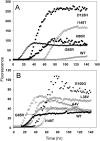Loss of metal ions, disulfide reduction and mutations related to familial ALS promote formation of amyloid-like aggregates from superoxide dismutase
- PMID: 19325915
- PMCID: PMC2659422
- DOI: 10.1371/journal.pone.0005004
Loss of metal ions, disulfide reduction and mutations related to familial ALS promote formation of amyloid-like aggregates from superoxide dismutase
Abstract
Mutations in the gene encoding Cu-Zn superoxide dismutase (SOD1) are one of the causes of familial amyotrophic lateral sclerosis (FALS). Fibrillar inclusions containing SOD1 and SOD1 inclusions that bind the amyloid-specific dye thioflavin S have been found in neurons of transgenic mice expressing mutant SOD1. Therefore, the formation of amyloid fibrils from human SOD1 was investigated. When agitated at acidic pH in the presence of low concentrations of guanidine or acetonitrile, metalated SOD1 formed fibrillar material which bound both thioflavin T and Congo red and had circular dichroism and infrared spectra characteristic of amyloid. While metalated SOD1 did not form amyloid-like aggregates at neutral pH, either removing metals from SOD1 with its intramolecular disulfide bond intact or reducing the intramolecular disulfide bond of metalated SOD1 was sufficient to promote formation of these aggregates. SOD1 formed amyloid-like aggregates both with and without intermolecular disulfide bonds, depending on the incubation conditions, and a mutant SOD1 lacking free sulfhydryl groups (AS-SOD1) formed amyloid-like aggregates at neutral pH under reducing conditions. ALS mutations enhanced the ability of disulfide-reduced SOD1 to form amyloid-like aggregates, and apo-AS-SOD1 formed amyloid-like aggregates at pH 7 only when an ALS mutation was also present. These results indicate that some mutations related to ALS promote formation of amyloid-like aggregates by facilitating the loss of metals and/or by making the intramolecular disulfide bond more susceptible to reduction, thus allowing the conversion of SOD1 to a form that aggregates to form resembling amyloid. Furthermore, the occurrence of amyloid-like aggregates per se does not depend on forming intermolecular disulfide bonds, and multiple forms of such aggregates can be produced from SOD1.
Conflict of interest statement
Figures






Similar articles
-
The Disulfide Bond, but Not Zinc or Dimerization, Controls Initiation and Seeded Growth in Amyotrophic Lateral Sclerosis-linked Cu,Zn Superoxide Dismutase (SOD1) Fibrillation.J Biol Chem. 2015 Dec 18;290(51):30624-36. doi: 10.1074/jbc.M115.666503. Epub 2015 Oct 28. J Biol Chem. 2015. PMID: 26511321 Free PMC article.
-
Initiation and elongation in fibrillation of ALS-linked superoxide dismutase.Proc Natl Acad Sci U S A. 2008 Dec 2;105(48):18663-8. doi: 10.1073/pnas.0807058105. Epub 2008 Nov 20. Proc Natl Acad Sci U S A. 2008. PMID: 19022905 Free PMC article.
-
Cu/Zn Superoxide Dismutase Forms Amyloid Fibrils under Near-Physiological Quiescent Conditions: The Roles of Disulfide Bonds and Effects of Denaturant.ACS Chem Neurosci. 2017 Sep 20;8(9):2019-2026. doi: 10.1021/acschemneuro.7b00162. Epub 2017 Jun 20. ACS Chem Neurosci. 2017. PMID: 28585802
-
Posttranslational modifications in Cu,Zn-superoxide dismutase and mutations associated with amyotrophic lateral sclerosis.Antioxid Redox Signal. 2006 May-Jun;8(5-6):847-67. doi: 10.1089/ars.2006.8.847. Antioxid Redox Signal. 2006. PMID: 16771675 Free PMC article. Review.
-
SOD1 aggregation and ALS: role of metallation states and disulfide status.Curr Top Med Chem. 2012;12(22):2560-72. doi: 10.2174/1568026611212220010. Curr Top Med Chem. 2012. PMID: 23339308 Review.
Cited by
-
Small molecules present in the cerebrospinal fluid metabolome influence superoxide dismutase 1 aggregation.Int J Mol Sci. 2013 Sep 17;14(9):19128-45. doi: 10.3390/ijms140919128. Int J Mol Sci. 2013. PMID: 24048249 Free PMC article.
-
A theoretical study on Zn binding loop mutants instigating destabilization and metal binding loss in human SOD1 protein.J Mol Model. 2017 Apr;23(4):103. doi: 10.1007/s00894-017-3286-z. Epub 2017 Mar 7. J Mol Model. 2017. PMID: 28271284
-
FTIR spectroscopic imaging of protein aggregation in living cells.Biochim Biophys Acta. 2013 Oct;1828(10):2339-46. doi: 10.1016/j.bbamem.2013.01.014. Epub 2013 Jan 25. Biochim Biophys Acta. 2013. PMID: 23357359 Free PMC article. Review.
-
Copper and zinc metallation status of copper-zinc superoxide dismutase from amyotrophic lateral sclerosis transgenic mice.J Biol Chem. 2011 Jan 28;286(4):2795-806. doi: 10.1074/jbc.M110.186999. Epub 2010 Nov 10. J Biol Chem. 2011. PMID: 21068388 Free PMC article.
-
Altered thiol chemistry in human amyotrophic lateral sclerosis-linked mutants of superoxide dismutase 1.J Biol Chem. 2014 Sep 26;289(39):26722-26732. doi: 10.1074/jbc.M114.565333. Epub 2014 Aug 4. J Biol Chem. 2014. PMID: 25096579 Free PMC article.
References
-
- Chiti F, Dobson CM. Protein misfolding, functional amyloid and human disease. Annu Rev Biochem. 2006;75:333–366. - PubMed
-
- Cleveland DW, Rothstein JD. From Charcot to Lou Gehrig: deciphering selective motor neuron death in ALS. Nat Rev Neurosci. 2001;2:806–819. - PubMed
-
- Valentine JS, Doucette PA, Potter SZ. Copper-zinc superoxide dismutase and amyotrophic lateral sclerosis. Annu Rev Biochem. 2005;74:563–593. - PubMed
-
- Rakhit R, Chakrabartty A. Structure, folding and misfolding of CuZn superoxide dismutase in amyotrophic lateral sclerosis. Biochim Biophys Acta. 2006;1762:1025–1037. - PubMed
-
- Shaw BF, Valentine JS. How do ALS-associated mutations in superoxide dismutase 1 promote aggregation of the protein? Trends Biochem Sci. 2007;32:78–85. - PubMed
Publication types
MeSH terms
Substances
Grants and funding
LinkOut - more resources
Full Text Sources
Medical
Research Materials
Miscellaneous

